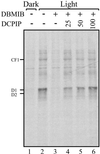Translation of chloroplast psbA mRNA is regulated by signals initiated by both photosystems II and I
- PMID: 11593046
- PMCID: PMC59807
- DOI: 10.1073/pnas.211440698
Translation of chloroplast psbA mRNA is regulated by signals initiated by both photosystems II and I
Abstract
Light controls the translation of several mRNAs in fully developed chloroplasts via at least two regulatory pathways. In the first, the light signal is transduced as a thiol-mediated signal that modulates translation in parallel to light intensity. The second light-controlled pathway, termed priming, is a prerequisite to the thiol-mediated regulatory pathway. Light regulation is rapid and requires intrachloroplast photoreceptor(s). To delineate the signaling pathways controlling each of these regulatory events, we assayed the effect of photosynthetic inhibitors and electron donors on the translation of chloroplastic psbA mRNA. We show that the thiol-mediated signal is generated by photosystem I and transduced by vicinal dithiol-containing proteins. We also found that the priming signal probably initiates on reduction of plastoquinone. These findings suggest that translation of chloroplast psbA mRNA is controlled by both linear photosynthetic electron transport, exerted by the reduction of the ferredoxin-thioredoxin system, and the relative activities of photosystems I and II, signaled by the redox state of the plastoquinone pool. These data underscore the function of the light-capturing reactions of photosynthesis as chloroplast photoreceptors.
Figures





Similar articles
-
Translation of chloroplast psbA mRNA is modulated in the light by counteracting oxidizing and reducing activities.Mol Cell Biol. 2000 Feb;20(4):1116-23. doi: 10.1128/MCB.20.4.1116-1123.2000. Mol Cell Biol. 2000. PMID: 10648596 Free PMC article.
-
Balancing the two photosystems: photosynthetic electron transfer governs transcription of reaction centre genes in chloroplasts.Philos Trans R Soc Lond B Biol Sci. 2000 Oct 29;355(1402):1351-9. doi: 10.1098/rstb.2000.0697. Philos Trans R Soc Lond B Biol Sci. 2000. PMID: 11127990 Free PMC article. Review.
-
Evidence for light/redox-regulated splicing of psbA pre-RNAs in Chlamydomonas chloroplasts.RNA. 1997 Jan;3(1):37-48. RNA. 1997. PMID: 8990397 Free PMC article.
-
Photosynthetic electron flow regulates transcription of the psaB gene in pea (Pisum sativum L.) chloroplasts through the redox state of the plastoquinone pool.Plant Cell Physiol. 2000 Sep;41(9):1045-54. doi: 10.1093/pcp/pcd031. Plant Cell Physiol. 2000. PMID: 11100777
-
Central role of cyclic electron transport around photosystem I in the regulation of photosynthesis.Curr Opin Biotechnol. 2014 Apr;26:25-30. doi: 10.1016/j.copbio.2013.08.012. Epub 2013 Sep 21. Curr Opin Biotechnol. 2014. PMID: 24679254 Review.
Cited by
-
Thioredoxins in chloroplasts.Curr Genet. 2007 Jun;51(6):343-65. doi: 10.1007/s00294-007-0128-z. Epub 2007 Apr 13. Curr Genet. 2007. PMID: 17431629 Review.
-
Hypothesis: A binary redox control mode as universal regulator of photosynthetic light acclimation.Plant Signal Behav. 2010 Jan;5(1):81-5. doi: 10.4161/psb.5.1.10294. Plant Signal Behav. 2010. PMID: 20592819 Free PMC article.
-
Inhibition of the repair of photosystem II by oxidative stress in cyanobacteria.Photosynth Res. 2005 Jun;84(1-3):1-7. doi: 10.1007/s11120-004-6434-0. Photosynth Res. 2005. PMID: 16049747 Review.
-
ACHT4-driven oxidation of APS1 attenuates starch synthesis under low light intensity in Arabidopsis plants.Proc Natl Acad Sci U S A. 2015 Oct 13;112(41):12876-81. doi: 10.1073/pnas.1515513112. Epub 2015 Sep 30. Proc Natl Acad Sci U S A. 2015. PMID: 26424450 Free PMC article.
-
Dynamic plastid redox signals integrate gene expression and metabolism to induce distinct metabolic states in photosynthetic acclimation in Arabidopsis.Plant Cell. 2009 Sep;21(9):2715-32. doi: 10.1105/tpc.108.062018. Epub 2009 Sep 8. Plant Cell. 2009. PMID: 19737978 Free PMC article.
References
-
- Klein R R, Mullet J E. J Biol Chem. 1987;262:4341–4348. - PubMed
-
- Krupinska K, Apel K. Mol Gen Genet. 1989;219:467–473.
Publication types
MeSH terms
Substances
LinkOut - more resources
Full Text Sources
Other Literature Sources

